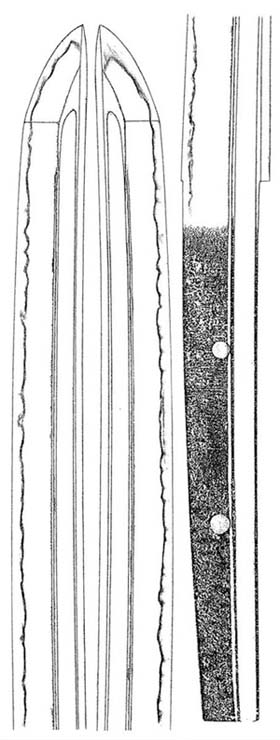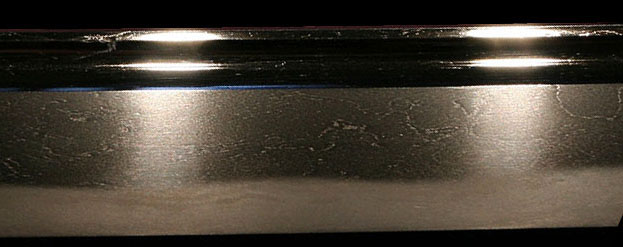YAMATO SHIZU School
KANETOMO(1) KEM-MU (t:KANEUJI 1): TEGAI. Moved with KANEUJI(1) to
MINO, changing the first character of his name along with
his KEM-MU YAMATO style. He was a maker of important
pieces. ZAI-MEI are to be carefully judged. See MINO.
MEI: KANETOMO
KANETOMO(2)TEI-JI (f:KANETOMO 1): TEGAI. Thought to be NAOE
KANETOMO (MINO KANETOMO 2). HIRA-TSUKURI, MITSU-MUNE,
strong and wide KO-WAKIZASHI. Luminous ITAME-HADA under a
veil of JI-NIE. KO-NIE DEKI shallow NOTARE GUNOME-MIDARE
with some KO-ASHI and YO. SUNAGASHI. HAKIKAKE BOSHI with
TSUKI-AGE KAERI (thrust and swept).
MEI: KANETOMO
KANETOMO(3) O-EI: TEGAI. While his forebears, KANETOMO(1) and (2),
championed SHIZU in MINO,KANETOMO(3) stayed in YAMATO.
O-EI style overtook his later work from a beginning of
late NAMBOKUCHO style, an appraisal note. SHINOGI-
TSUKURI, IHORI-MUNE, strongly curved KO-KISSAKI TACHI.
ITAME MOKUME that runs. KO-NIE NOTARE GUNOME HA with
SUNAGASHI and KINSUJI, where NIOI is clear. O-MARU or
HAKIKAKE BOSHI with KO-MARU and long turnback.
MEI: KANETOMO
YAMATO-no-KUNI KANETOMO
KANETOMO(4) EI-KYO: TEGAI. SUGUHA or GUNOME-MIDARE patterns with
SUNAGASHI in NIE.
MEI: KANETOMO
WASHU TEGAI JU KANETOMO
Kaneuji
Nagasa: 6 Sun 5 Bu
(19.7cm)
MuSori
Moto-haba: 6 Bu 6 Rin (2cm)
Moto-kasane: 1 Bu (0.45cm)
Nakago: 2 Sun 6 Bu (8.02cm)
Nakagozori: 5 Rin (0.15cm)
Hira-tsukuri, Mitsu-mune
Tanto. Yamato Shizu origin.
Ko-Itame, Masame mixed Hada has Ji-Nie
dappling on the surface.
Asaki-Notare, very gentle undulation of
Ko-Gunome Midare Ba in fine Ko-Nie and
deep Nioi-Fukashi.
Boshi becomes deep to Ko-Maru in very fine
Ko-Nie Hakikake.
Curved, evenly-wide Furisode style Nakago
with two Mekugi-ana.
Signed:
Kaneuji |
|
Juyo
Bunkazai Kaneuji

|
|


